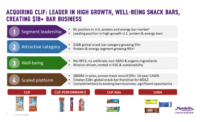Amazon.com has struck a deal with Whole Foods Market Inc., and will acquire the supermarket chain for $13.7 billion.
Amazon will pay $42/share in cash for the chain, and John Mackey, the co-founder of Whole Foods, will continue to run the business.
The news came as a surprise to both online and brick-and-mortar industries, as the two brands were not obvious partners. When activist investor Jana Partners acquired more than an 8 percent share in the company, and wanted a buyout, Whole Foods needed to find a buyer; by Amazon acquiring the company, Mackey is able to keep his job as chief executive officer of Whole Foods.
When news of the acquisition hit, Whole Foods stock shares jumped 27 percent, and Amazon shares gained 3.2 percent.
Amazon now will have a distribution outlet for groceries, as it has spent years trying to conceive a platform for delivering groceries.
The acquisition is scheduled for the second half of the year, and Whole Foods' headquarters will continue to remain in Austin, TX.
Stats about the acquisition, from Mergermarket:
In addition to being the top grocery deal in the US over the last 10 years, the Amazon/Whole Foods transaction is also the fourth-largest US deal in the retail sub-sector on Mergermarket record (which goes back to 2001)
- Amazon/Whole Foods accounts for 57.7% of the Retail sub-sector’s total deal value in the year to date
- The transaction is the second-largest US grocery deal on record after Cerberus Capital Management, CVS Health Corp, and SuperValue bought out Albertsons in 2006 for US$ 17.4bn
- US Retail M&A in the year to date has reached 53 deals worth US$ 23.4bn, up 432% in value, or more than 5x, the sub-sector’s total deal value from the same period in 2016
- The deal further boosts the overall Consumer sector, which is the top industry so far in 2017, reaching 202 deals worth a total of US$ 127.3bn. Of this, Retail accounts for 18.4% of the sector’s value
- Structural changes in retail have put a lot of pressure on brick-and-mortar supermarket chains in recent years. With changing consumer habits spilling over into decisions in the grocery aisle, and food retailers ceding some market share to even Amazon as well as e-commerce upstarts in the bourgeoning grocery and mealkit delivery space, an uptick in consolidation in the food retail industry is not surprising, with further M&A opportunities expected as assets become available amidst increasing competition, store closures, and bankruptcies
- As the likes of Amazon and e-commerce upstarts continue to alter the way people consume in response to a fundamental shift not only in technology, but also in habits, the future of brick-and-mortar chains becomes cloudier. The ever-growing popularity of mobile shopping, the “experience” economy, and direct-to-consumer e-retail has rendered this especially true for companies slow to embrace such changes. Even behemoth retailers such as Walmart [NYSE:WMT] and Target [NYSE:TGT] have begun to adopt aggressive e-commerce strategies -- which maybe spurred on some of Amazon’s desire to purchase Whole Foods -- while also offering groceries alongside their usual personal and home products in their own efforts to survive. Amazon and Walmart’s increased competition following the latter’s purchase of Jet.com last year was just the beginning of the fight for market share. As consumers strive for convenience, the added competition only intensifies the pressure already on the supermarket industry.
Source: bloomberg.com, 6/16/17, "Amazon to Acquire Whole Foods for $13.7 Billion"






